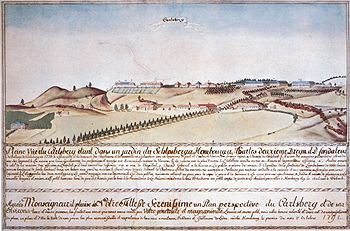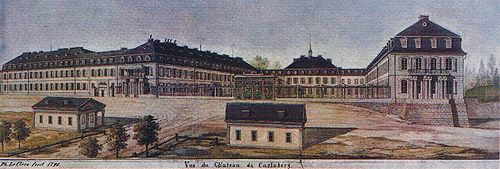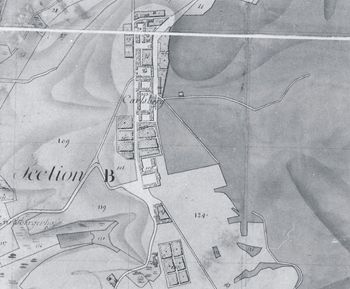
Karlsberg castle
Encyclopedia

Homburg
-In Germany:* Homburg, Saarland, capital of the Saarpfalz district of Saarland* Bad Homburg, town and spa in Hesse* Homburg Forest, a hill range in Lower Saxony* Homburg, a quarter of Triefenstein, Bavaria...
in Saarland
Saarland
Saarland is one of the sixteen states of Germany. The capital is Saarbrücken. It has an area of 2570 km² and 1,045,000 inhabitants. In both area and population, it is the smallest state in Germany other than the city-states...
, Germany. The castle was constructed from 1778 to 1788 in Baroque
Baroque architecture
Baroque architecture is a term used to describe the building style of the Baroque era, begun in late sixteenth century Italy, that took the Roman vocabulary of Renaissance architecture and used it in a new rhetorical and theatrical fashion, often to express the triumph of the Catholic Church and...
and Classical
Classical architecture
Classical architecture is a mode of architecture employing vocabulary derived in part from the Greek and Roman architecture of classical antiquity, enriched by classicizing architectural practice in Europe since the Renaissance...
style by Johann Christian von Mannlich
Johann Christian von Mannlich
Johann Christian von Mannlich was a German painter and architect.-Biography:Von Mannlich was born in Strasbourg in 1741, the son of Konrad von Mannlich, court painter to Christian IV, Duke of Zweibrücken...
, architect and general building director of the dukes of Zweibrücken
Zweibrücken
Zweibrücken is a city in Rhineland-Palatinate, Germany, on the Schwarzbach river.- Name :Zweibrücken appears in Latin texts as Geminus Pons and Bipontum, in French texts as Deux-Ponts. The name derives from Middle High German Zweinbrücken...
, by order of Charles II August, Duke of Zweibrücken
Charles II August, Duke of Zweibrücken
Charles II/III August Christian was Duke of Zweibrücken from 1775 to 1795. He was the son of Frederick Michael of Zweibrücken-Birkenfeld and Maria Franziska of Sulzbach...
. The castle was the largest country palace of Europe and served as the residence of the duke of Zweibrücken. In 1793 the castle was destroyed by French revolutionary troops.
Historical situation
Charles II August was the son of the (titular) Count Palatine and prince of Palatinate-Zweibrücken and Palatinate-Birkenfeld-Bischweiler Frederick MichaelCount Palatine Frederick Michael of Zweibrücken
Frederick Michael, Count Palatine of Zweibrücken-Birkenfeld was a member of the Wittelsbach dynasty. He was the father of Maximilian I Joseph of Bavaria...
. This means, his father was the head of the house Palatinate-Birkenfeld-Bischweiler, a side branch of the house Palatinate-Zweibrücken-Birkenfeld, which was a side branch of the ducal house of Palatinate-Zweibrücken, which itself was a side branch of the house of Wittelsbach-Palatinate, which held the title of elector Palatinate of the Rhine and was the Protestant branch of the house of Wittelsbach.
His upbringing as the son of an unimportant poor prince did not give Charles II August the chance to build a castle of European standing. It was the extinction of the three main branches of the house of Wittelsbach, which gave him the opportunity to do so. In 1775 Christian IV
Christian IV, Count Palatine of Zweibrücken
Christian IV, Count Palatine of Zweibrücken-Birkenfeld was Duke of Zweibrücken from 1735 to 1775. He was the son of Christian III, Count Palatine of Zweibrücken and Caroline of Nassau-Saarbrücken.In 1751 he married, morganatically, Maria Johanna Camasse...
, duke of Zweibrücken died without legitimate children. Charles August became his successor. At the same time, neither Charles Theodore, Elector of Bavaria
Charles Theodore, Elector of Bavaria
Charles Theodore, Prince-Elector, Count Palatine and Duke of Bavaria reigned as Prince-Elector and Count palatine from 1742, as Duke of Jülich and Berg from 1742 and also as Prince-Elector and Duke of Bavaria from 1777, until his death...
, Elector Palatine, the head of the Protestant main branch of the house of Wittelsbach, nor Maximilian III Joseph, Elector of Bavaria, the head of the Catholic main branch of the house of Wittelsbach, had surviving legitimate children. So Charles August was expected to succeed these relatives too.
Charles Theodore was not interested in the Bavarian inheritance (because of their illegitimate birth, his own children would not benefit from the inheritance). Therefore he was willing to sell his hereditary title and, after the death of Maximilian Joseph, his Bavarian property to the Austrian house of Habsburg.
The European powers, especially Prussia, were not interested in seeing the house of Habsburg make further land gains. The only way to prevent this from happening was to make sure that, instead of selling his own hereditary title too, Charles August protested against every attempt to impede his succession to the Bavarian throne. To insure this, Charles August received financial support from European powers such as France and Prussia. Part of the demonstration of his position as the inheritor of the Electoral Palatinate and Bavaria was an extensive holding of court.
Construction
Architect of the castle was Johann Christian von Mannlich, painter and architect, who held the office general building director of the duke of Zweibrücken.
On July 27, 1777, duke Charles II August bought the Luisenhof for the price of 23,000 gulden (a journeyman had to work two days to earn one Gulden) and 60 new Louis d'or (about twice the worth of a gulden). He was influenced by his mistress, Caroline von Esebeck, a cousin of the owner, who was seeking to sell the property she did not use any more, because she lived with her new husband, the count of Strahlenheim-Wasaburg in Forbach
Forbach
Forbach is a commune in the Moselle department in Lorraine in north-eastern France.It is located near the German border. Population : 22,784....
.
From 1778 to 1788, a castle was constructed on the area of the Louisenhof. Leading architect was Johann Christian von Mannlich (born 2 October 1741, Strasbourg; died 3 January 1822, Munich), a painter and architect, who became court painter and general building director of the duke of Zweibrücken.
The castle was constructed in the style of classicism
Classicism
Classicism, in the arts, refers generally to a high regard for classical antiquity, as setting standards for taste which the classicists seek to emulate. The art of classicism typically seeks to be formal and restrained: of the Discobolus Sir Kenneth Clark observed, "if we object to his restraint...
. It was one of the first buildings within the Holy Roman Empire constructed in this new style.
The main entrance was located in the valley in front of the castle. There the Karlsberger Hof (Karlsberg grange), a farm building, was constructed. This is the only building of the castle complex that is still intact. From there, a meandering road led to the mansion, a three winged building, arranged around a court of honour.
The main buildings were constructed along the edge of a hill, giving a view over the surrounding countryside.

In 1778 the construction of the first buildings began. Several buildings were constructed at the same time.
Timetable
| 1778 - 1780 well and water conduits 1778 - 1782 corps de logis, tavern and brewery 1778 - 1785 stables 1779 - 1785 cavaliers house 1779 - 1783 Dutch nursery and greenhouses 1779 - 1794 northern wing of the mansion 1779 - 1782 dovecote 1779 - 1786 menagerie 1779 - 1780 Tschifflik pavillon 1779 - 1784 construction of the kitchen wing 1780 - 1785 southern wing of the mansion 1780 - 1783 chinoisierie 1780 conversion of the creamery to an orangery 1780 - 1783 kennel 1780 - 1784 hunter's lodge, from 1791 barracks 1780 - 1782 court nursery |
1780 - 1781 pheasant house 1780 - 1784 big cascade and higher pool 1781 pineapple greenhouse 1781 - 1782 kitchen wing 1782 amphitheater 1782 beginning of the construction of the western wing 1782-85 depots 1782 gate lodge 1783 comedians house 1783 fountain house Hischwürzloch 1783 beehouse 1783-84 pleasure house of the prince 1784 pleasure garden of the duchess 1785 rotunda (on occasion of the marriage of the Count Palatine Maximilian Joseph) 1788 gallery wing |
In 1779 the castle became the residence of the dukedom. The castle was more than just a mansion with a garden, connected, to it. In addition to the mansion itself, there was a full functional small village with barracks, farms, nurseries, kennels and stables.
Exterior

Corps de logis
With 42 meters, the staircase was one of the biggest of the Baroque period.
In the upper floor, the state rooms could be found.
General
Main parts of the equipement of the castle were created by purveyors to the French court. Other parts came from older castles of the dukes of Zweibrücken.
Most of the elaborate carved and gilded furnitures and plankings were created by the French court cabinetmaker Georges Jacob gefertigt. Sculptures were produced by the French sculptors Francois-Joseph Duret and Martin-Claude Monot. The silverware was created by Jean-Jacques Kirstein in Strassburg and the drapery came from Lyon. The equipment followed the plans of Johann Christian von Mannlich und Jean-Démosthène Dugourc.
Corps de logis
The main piece of the show bedroom was a bed "à la Romaine", which was the archetype of following furniture of the kings of France. Main parts of the furnitures of this room can be found at the Munich residence and Berchtesgaden castle.
The garden
The garden has three parts, the park nearby the mansion, Karlslust (Charles' pleasure) and Hirschwürzloch.The park near the mansion is a baroque style; Karlslust and Hirschwürzlust are English parks. It is not known who created the gardens. It looks like Mannlich worked on the plans but Friedrich Ludwig von Sckell did as well.
The court gardener, Johann Ludwig Petri, who created important parts of the park of Schwetzingen castle, seems to have been involved too. Other court gardeners were Ernst August Bernhard Petri, Bernhard Petri and Matthias Sckell.
Destruction

Royal Deux-Ponts Regiment
The Régiment Royal Deux-Ponts, was a German-French infantry regiment created under the Ancien Regime in 1757.The regiment was raised on April 1 1757 by the duc de Deux-Ponts in his estates as well as in Alsatian bailiwicks. This family owned the Petite-Pierre county, the bailiwicks of Bischwiller,...
, within the French army, which participated in several battles, especially the siege of Yorktown
Siege of Yorktown
The Siege of Yorktown, Battle of Yorktown, or Surrender of Yorktown in 1781 was a decisive victory by a combined assault of American forces led by General George Washington and French forces led by the Comte de Rochambeau over a British Army commanded by Lieutenant General Lord Cornwallis...
, where they played a prominent part of taking redoubt 9. As compensation for this policy of neutrality, the duke was granted neutrality by the French government. Because of this guarantee, unlike other princes, the duke stayed within his dukedom, close to the French territory and the French armies. After the execution of Louis XVI, Charles II August was to be put on trial in front of a revolutionary tribunal, which would have meant his death. Before French troops could arrest him, he was warned by a nearby farmer and was able to escape to Mannheim
Mannheim
Mannheim is a city in southwestern Germany. With about 315,000 inhabitants, Mannheim is the second-largest city in the Bundesland of Baden-Württemberg, following the capital city of Stuttgart....
, to live in his castles of Mannheim and Rohrbach
Rohrbach
Rohrbach can refer to:* Heidelberg-Rohrbach, a district of the city of Heidelberg in Germany* Rohrbach, Switzerland, in the canton of Bern*municipalities in Germany:**Rohrbach, Bavaria, in the district of Pfaffenhofen, Bavaria...
near Heidelberg
Heidelberg
-Early history:Between 600,000 and 200,000 years ago, "Heidelberg Man" died at nearby Mauer. His jaw bone was discovered in 1907; with scientific dating, his remains were determined to be the earliest evidence of human life in Europe. In the 5th century BC, a Celtic fortress of refuge and place of...
.
Within the next six months, French and Prussian troops alternately gained control of the region around the castle. Protected by the Prussian army, the equipment was transported to Mannheim too.
When the French troops capitulated in Mainz, the relief troops retired back home to France. Leaving the region, they marauded the castle and the residents of the nearby villages were allowed to plunder the buildings. On the eve of July 28th, the French soldiers set fire to the main buildings. To be able to do so, about one hundred cartloads of straw had to be transported from Metz
Metz
Metz is a city in the northeast of France located at the confluence of the Moselle and the Seille rivers.Metz is the capital of the Lorraine region and prefecture of the Moselle department. Located near the tripoint along the junction of France, Germany, and Luxembourg, Metz forms a central place...
.
The fire did not destroy all of the buildings. The mansion was destroyed, but most of the service rooms and farming buildings were unaffected.
In the aftermath, the castle hill was still inhabited. In November 1793, there were still children born and documented in the church register. Until 1797, the court still settled accounts concerning the castle, although there were no real efforts to secure or maintain the buildings. Therefore the buildings decayed even more.
Napoleon returned the ruins to the duke's widow, under the condition that she remove all the ruins.
Parts of the furniture and equipment were auctioned off after the death of Charles II August. The rest was spread on several castles and museums of the house of Wittelsbach.
- The furniture was used in Nymphenburg castle, BerchtesgadenBerchtesgadenBerchtesgaden is a municipality in the German Bavarian Alps. It is located in the south district of Berchtesgadener Land in Bavaria, near the border with Austria, some 30 km south of Salzburg and 180 km southeast of Munich...
castle and the residences of Munich WürzburgWürzburgWürzburg is a city in the region of Franconia which lies in the northern tip of Bavaria, Germany. Located at the Main River, it is the capital of the Regierungsbezirk Lower Franconia. The regional dialect is Franconian....
and BambergBambergBamberg is a city in Bavaria, Germany. It is located in Upper Franconia on the river Regnitz, close to its confluence with the river Main. Bamberg is one of the few cities in Germany that was not destroyed by World War II bombings because of a nearby Artillery Factory that prevented planes from...
. - The collection of arms can be seen in the historic museum of Palatinate, the German museum of hunt and fishing in Munich and Berchtesgaden castle.
- Parts of the silverware are located in the silver chamber of the Munich RezidenzResidenz, MunichThe Munich Residenz is the former royal palace of the Bavarian monarchs in the center of the city of Munich, Germany...
. - The paintings formed the core of the alte PinakothekAlte PinakothekThe Alte Pinakothek is an art museum situated in the Kunstareal in Munich, Germany. It is one of the oldest galleries in the world and houses one of the most famous collections of Old Master paintings...
art collection. - The graphic collection came to the state graphic collection in Munich.
- The coins were included in the state coin collection in Munich.
- The books now are part of the Bamberg State LibraryBamberg State LibraryThe Bamberg State Library is a combined universal, regional and research library with priority given to the humanities. Today it is housed in the New Residence, the former prince-bishop's new palace...
.
Situation today
Today, only one building remains. The Karlsberger Hof, a former farmhouse near the main entrance of the castle territory. After serving for different purposes as a sugar factory or a forester's house, the Karsberger Hof is owned by the Karlsberg brewery.Of the other buildings nothing remains, except parts of the foundations. Soon after the destruction, the hill was forested. Within this forest, there are some ponds, especially the Karlsberg weiher (Karlsberg pond), which are remains of water basins of the castle park.

